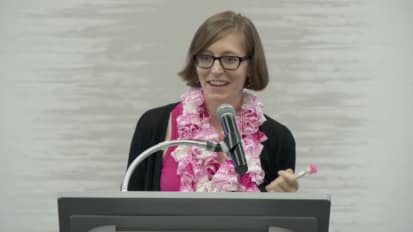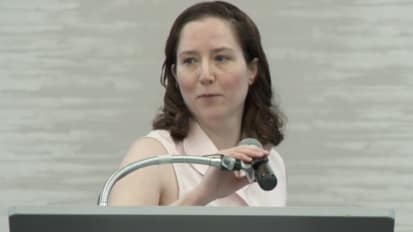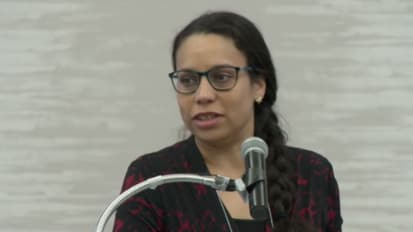Chapters
Transcript
DR. SUSAN MCLIN: I'm here today to talk about extending aromatase inhibitor therapy. I have no disclosures. The objectives are outlined of the talk. I'm going to do a little bit of background on long-term adjuvant endocrine treatment, presentation of plenary, session at ASCO the MA 17R study, some comments or conclusions, and then we'll do our questions.
So for people out there who don't normally treat breast cancer, hormone receptor positive, means estrogen or progesterone receptor positive. Breast cancers do benefit from adjuvant chemotherapy treatment. Tamoxifen, which is an estrogen receptor antagonist, is the gold standard and has been for many, many years.
It's been in existence for well-over 50 years and used in hundreds of clinical studies. In post-menopausal women, where the source of estradiol is actually derived from the adrenal glands and the conversion of the androgenic steroids to estradiol, is done through an enzyme called aromatase. So there's the development of aromatase inhibitors. And they do prove to be better in post-menopausal women.
This is a graph from the early breast cancer trial as co-operative group. Which is otherwise known as the Oxford overview, if you've heard that. That is a large global collaborative group where they have a huge database of hundreds of clinical studies that they've been compiling since the mid '90s.
And every couple of years, they come up with a meta-analysis with longer and longer outcomes of these clinical studies. So this has to do with five years of Tamoxifen. And patients who were ER positive, they were primarily premenopausal and the majority of them had gotten chemotherapy.
They were treated with five years of Tamoxifen. And you can see the breast cancer mortality as well as any death at five years, was about 3%. You go out to 10 years, and it's 7%. You get to 15 years and your gain is 10.6% for breast cancer mortality as well as any death, showing a carry over effect from Tamoxifen. And that was published in 2011. So they do these updates and these meta-analysis about every five years.
The NSABP B-14, trial, very important trial, where they treated patients who were node-negative, ER positive, with five years of Tamoxifen versus placebo. And then there was a second randomization where they treated patients with an additional five years of Tamoxifen versus placebo.
And this is actually shows that patients who were treated with five more years of Tamoxifen versus placebo, actually did a little bit worse. Disease-free survival was off by about 4%, overall survival by 3%. That was not statistically significant.
So they thought back then, because this was published in 2001, that additional Tamoxifen, you probably got more endometrial cancer, ischemic heart disease, strokes, and thromboembolic phenomena and that Tamoxifen may at that point, be acting more as an estrogen, and therefore stimulating tumor growth.
So this resulted in basically, five years of Tamoxifen stop, and there we are. Along comes two other very large international studies. The first one, the ATLAS Study Adjuvant Tamoxifen Longer Versus Shorter. And the aTOM Study which was done in the UK, this was an international study, accruing for almost 10 years.
And it took almost 13,000 patients who had early-stage breast cancer, had been treated with five years of Tamoxifen, and then randomized them to an additional five years or stop. The aTOM Study was very similar with almost 7000 patients, but the same sort of schema. And this was recently that ATLAS study I'll discuss, was recently published in 2013.
And what this shows is in close to 7,000 patients, so they entered the Atlas study here. And they were treated for five years with either Tamoxifen or placebo. And you can see that the recurrence at five years was a modest around 3%. Overall survival was essentially the same.
Treatment stops at five years and then you follow them for an additional five years. And you can see that the curves start to diverge. And recurrence is decreased by about 4% overall survival. Or breast cancer mortality decreased by 3%. And this was independent of either age, nodal status, and non-cancer breast cancer deaths were not significant.
There have been many studies as I said, looking at aromatase inhibitors, comparing them either directly to Tamoxifen, so the pink is Tamoxifen, versus aromatase inhibitors. Switching them at two to three years, extending them, that's this MA-17 Study, or sequencing them.
And suffice it to say that aromatase inhibitors went out. They basically have been shown to work much better in post-menopausal women. The MA-17 Study, the one we'll talk about is an extension of, took post-menopausal women, or they could have been premenopausal during this first five years.
So five years of adjuvant Tamoxifen and then they were randomized to either five years of Letrozole versus placebo. Primary endpoint was disease-free survival. Secondary endpoints where overall survival, safety, and quality of life issues. There were close to 5,200 patients. And as I said, post-menopausal.
They had an interim analysis at about 2, 2 and 1/2 years. And they un-blinded the study, because clearly Letrozole was benefiting these patients, particularly those who were at high risk. Patients who were on the placebo arm were offered Letrozole and actually, even though they'd been off of all endocrine therapy for 2, 2 and 1/2 years, they actually benefited from it.
So here we come to the MA-17R Clinical Study. This was presented in a plenary session at ASCO and plenary abstracts are supposed to be practice changing. So I thought it worthwhile. It's looking at extending the aromatase inhibitor, Letrozole after five years of initial aromatase inhibitor therapy.
And they could have either been preceded by Tamoxifen or not. In post-menopausal women, early-stage breast cancer, randomized Phase III, Open Label Trial by Doctor Paul Goss is who presented it from Harvard. So it was a North American study with the United States and Canada.
So the schema of this study looked at you could have had any duration of proper Tamoxifen. Most of them 5 years, and then 4 and 1/2 to 6 years of aromatase inhibitor. And then randomized to Letrozole versus placebo. There were three different cohorts to this study. The first cohort was the MA-17 patients. So they'd gone through five years of Tamoxifen, five years of Letrozole, and then were randomized.
The second cohort to the study could have been patients who had had some Tamoxifen 2 years or 3 years' worth and then switched to an aromatase inhibitor. And then the third cohort to the study, were patients who were treated with just an aromatase inhibitor for usually five years.
That constituted about 20% of patients. The other two cohorts were 80% of the patients. And as I said, they had completed somewhere between 4 and 1/2 and 6 years of an aromatase inhibitor.
We go back to NSABP B14. These survival curves show five years of Tamoxifen versus placebo. And well out at 15 years, you can see that disease-free survival, there's a carry over effect, if you will, with the use of years of Tamoxifen. Overall survival, not statistically significant.
So the MA-17 Study that I alluded to earlier, five years of Tamoxifen, then Letrozole versus placebo. At 60 months they had a disease-free survival, with a significant hazard ratio of 0.57 and a p-value of 0.001. Overall survival was not statistically significant.
But if you then take it out to 64 months, you still have the disease-free survival is significant. And then overall survival does become statistically significant with a 39% reduction in mortality. So MA-17R Study, the hypothesis was, does extending aromatase inhibitor treatment from five to 10 years, further improve patient outcome?
The primary objective was disease-free survival, from randomization to the time of either recurrence or development of a contralateral breast cancer, whichever came first. Secondary objectives, overall survival, all contralateral breast cancer, safety, and quality of life that was reported in a separate session, tomorrow.
Stratification was by lymph node status, prior adjuvant chemotherapy, the interval between the last dose of aromatase inhibitor and randomization, and then duration of Tamoxifen. Either no Tamoxifen, 0-2, 2- 4 and 1/2 or greater than 4 and 1/2.
The statistical considerations, initially they projected that 198 disease-free survival events in 1800 patients would be needed to achieve a power of 80% to detect a hazard ratio 0.67, and a 66% reduction in recurrences, which is fairly standard for these clinical studies, at a two-sided alpha of 5%.
What they found is based on a lower than expected event rate, patients doing very well, they had to amend the trial design so that it was based on time, rather than event. And then the final database did provide an 80% power, to detect what they needed to. There were no interim analysis planned.
So the results. Looking at key baseline characteristics between Letrozole and placebo by age, race, performance status, time of diagnosis over 10 years, tumor size, nodal status, of course hormone receptor positive, and then Tamoxifen adjuvant chemotherapy almost 60% in both arms. Mastectomy about 50% in both arms.
Primary endpoint, disease-free survival at a median follow-up of 6.3 years. Disease-free survival in the Letrozole arm 95%, versus 91% in the placebo arm. It didn't reach its statistical significance with a hazard ratio of 0.66 and a p-value of 0.01 64% reduction in recurrences.
This table shows where those recurrences were. The distant recurrences 42 versus 63. Local regional recurrences were decreased in the Letrozole arm. Bone recurrences and then, new contralateral breast cancer significantly decreased in the Letrozole arm.
So not only adjuvant treatment, but also a preventative treatment. This is a forest plot that looks at stratification by nodal status, prior chemotherapy, last dose of randomization, all of those that we talked about. All of them favoring Letrozole versus the placebo.
This graph shows you the decrease in contralateral breast cancer. So with Letrozole versus placebo, highly statistically significant with a 58% reduction in contralateral breast cancers and a significant p-value.
Overall survival at 6.3 years, not significantly different. In fact, the same. Toxicities during treatment, so the ones we think about when starting aromatase inhibitors, hot flashes mialgias, arthralgia, vaginal dryness, were essentially the same in both arms. So essentially, if you've been on an aromatase inhibitor for five years, you can tolerate it for an additional five years.
Bone pain was a little bit worse in the Letrozole arm and hepatotoxicity. Cardiovascular events essentially the same. So those are sort of systemic side effects, but we always worry about bone health, because we all know that the aromatase inhibitors can affect bone density and increase bone loss.
At the onset of the clinical trial, fractures, osteoporosis, and baseline T-scores for hip and spine where essentially the same. Medications for prevention or treatment of osteoporosis during this study treatment, most patients, the majority were on calcium and vitamin D. About half of them on bisphosphonates.
I was a little surprised to see that they even allowed serums to be on this study, since they could have a potential treatment effect. But toxicities so, more bone fractures, that was statistically significant. Surprisingly, despite the fact there were more more bone fractures, the ones that they think about as far as fragility is concerned, are spine, wrist, and then pelvis. Pelvis, hip, and femur were not statistically significant.
There was a slight increase in ankle and then other. So I'm not sure where other is. New onset osteoporosis, clearly those patients in the Letrozole arm had an increased risk for it, almost double. Quality of life issues, they used two different measurements. The MEN quality, which is the menopause QOL, which looks at four different subscales. Has to do with sexual, physical, vasomotor, and psychological, I think. I think there's four.
And then they have this SF-36 that looks at eight different subscales. There essentially, was no difference in the two groups. They looked at them at baseline and then every year, for the five years. So suffice it to say there were no differences.
So in summary, the MA-17R is the first study to show benefit of extending aromatase inhibitors beyond five years, resulting in a 34% reduction in disease recurrences. There was no worsening of quality of life observed by extending Letrozole. No new toxicities associated with extending Letrozole. Bone health of course, remains a very big concern, risk versus benefit. And then importantly, unlike a lot of cancer treatments, the aromatase inhibitors are readily accessible and therefore these results may further improve the outcome of many patients with breast cancer around the world.
So he thanked patients and family and then these were the co-operative groups in the United States in conjunction with the Canadian cancer trials group that conducted this study with industry support from Novartis. Following this presentation, there was a discussant, who is Dr. Ian Smith from the United Kingdom, who congratulated Doctor Goss on his study and results.
Went on to talk about other trials of extending aromatase adjuvant therapy. Most of them involving some duration of Tamoxifen, but pointed out that NSABP B42 is a study that did start some patients on just an aromatase inhibitor. And then after five years randomized them to an additional AI therapy versus placebo.
So this would be looking at purely 10 years worth in one arm. So his conclusions, how should clinicians react to the MA-17R? For a small but important subset of patients, there's a continued risk of relapsing. We've shown that ER positive patients can have relapses at 10, 15, 20 years out.
And that small 3.2%, but significant group of these patients do have an improved disease-free survival with 10 years of treatment with an aromatase inhibitor, compared with five, usually after Tamoxifen.
No major toxicities emerge from this prolonged treatment, but a reduction in contralateral breast cancer is what contributed significantly to the disease-free survival benefit. That there was only a 1.1% difference for distant recurrence, so far. And no significant improvement in survival benefit. So this data would not sustain a novel adjuvant therapy.
The view from the clinical scientists, we need to develop algorithms based on both clinical as well as genomic parameters for risk of late relapse so that the majority of patients who don't need prolonged therapy can be identified. And that data from other trials will help strengthen this type of analysis.
From a pragmatic standpoint, these data do not justify telling all our patients that they need to have extended treatment beyond 10 years. But that, for a patient who has high risk features, it's something to discuss with them. And then he showed this graph looking at three different genomic assays. The recurrent score which is the Oncotype DX, the IHC4, which is a pathologic assay
And then the risk of recurrence by the Prosigna or PAM50. And this looks at hazard ratios between 0 and 5 years. So low risk down here, for all three assays. High risk up here. They do pretty well and they look like they're pretty comparable. But if you go out, 6 to 10 years, the Oncotype DX tends to do a little bit poorer. And this Prosigna looks like it does a little bit better. So stay tuned. All right, that's it. Thank you very much.
Susan A. Melin, MD, discusses her topic, 'Extending Aromatase Inhibitor Adjuvant Therapy'.
Related Videos





